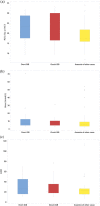Plasma urea:creatinine ratio as a biomarker of gastrointestinal bleeding in dogs with anaemia
- PMID: 37817453
- PMCID: PMC10650361
- DOI: 10.1002/vms3.1286
Plasma urea:creatinine ratio as a biomarker of gastrointestinal bleeding in dogs with anaemia
Abstract
Background: Gastrointestinal bleeding is a cause of anaemia in dogs. A reliable, non-invasive biomarker to differentiate gastrointestinal bleeding from other causes of anaemia would be advantageous to direct clinical decisions in anaemic patients. Plasma urea:creatinine ratio is an accepted biomarker of upper gastrointestinal bleeding in human medicine.
Objectives: The objective of this study was to evaluate plasma urea:creatinine ratio as a biomarker of gastrointestinal bleeding in a population of dogs with anaemia.
Methods: This was a prospective cross-sectional study of dogs with anaemia presenting to referral centres for the investigation of anaemia. Cases were categorised as having overt gastrointestinal bleeding (melena on presentation), occult gastrointestinal bleeding (historical and diagnostic findings consistent with gastrointestinal bleeding without melena at presentation) or anaemia of other cause (confident diagnosis other than gastrointestinal bleeding reached, normal diagnostic imaging of gastrointestinal tract). Urea:creatinine ratio at presentation was calculated by dividing urea (mg/dL) by creatinine (mg/dL).
Results: Ninety-five dogs were included. Plasma urea:creatinine ratio was not significantly different between dogs with overt or occult gastrointestinal bleeding or those with anaemia of other cause (median urea:creatinine ratio 25.8, 20.7 and 22.5, respectively). No significant difference in urea:creatinine ratio was found between dogs with upper and lower gastrointestinal bleeding (median urea:creatinine ratio 19.4 and 24.6, respectively).
Conclusions: Plasma urea:creatinine ratio was not helpful in differentiating between dogs with anaemia resulting from gastrointestinal bleeding (overt or occult) and those with other causes of anaemia.
Keywords: anaemia; clinical pathology; dog; gastrointestinal.
© 2023 Linnaeus Veterinary Limited. Veterinary Medicine and Science published by John Wiley & Sons Ltd.
Conflict of interest statement
The authors declare no conflicts of interest.
Figures


References
-
- Acierno, M. J. , Brown, S. , Coleman, A. E. , Jepson, R. E. , Papich, M. , Stepien, R. , & Syme, H. M. (2018). ACVIM consensus statement: Guidelines for the identification, evaluation, and management of systemic hypertension in dogs and cats. Journal of Veterinary Internal Medicine, 32(6), 1803–1822. - PMC - PubMed
-
- Atata, J. A. , Esievo, K. A. N. , Adamu, S. , Abdulsalam, H. , Avazi, D. O. , & Ajadi, A. A. (2019). Haemato‐biochemical studies of dogs with haemorrhage‐induced dehydration. Comparative Clinical Pathology, 28, 129–135.
-
- Blatchford, O. , Murray, W. R. , & Blatchford, M. (2000). A risk score to predict need for treatment for upper‐gastrointestinal haemorrhage. Lancet, 356(9238), 1318–1321. - PubMed
-
- Botsch, V. , Küchenhoff, H. , Hartmann, K. , & Hirschberger, J. (2009). Retrospective study of 871 dogs with thrombocytopenia. The Veterinary Record, 164, 647–651. - PubMed
Publication types
MeSH terms
Substances
LinkOut - more resources
Full Text Sources
Medical

